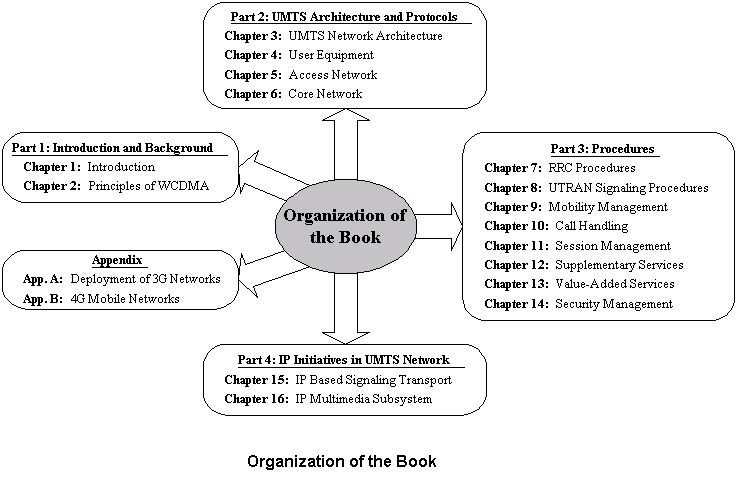Given this scenario, certain trends emerge. Firstly, as the subscriber base reaches saturation levels, growth needs to be sustained from new services and not from new subscribers. Also integration of voice and data will become quite critical. Secondly, as bandwidth limitations of existing wireless networks become a stumbling block, operators will need to devise novel means to overcome the limitation. This will entail deployment of new generation of networks that provide greater bandwidth, allowing application developers to popularize bandwidth-intensive multimedia applications. Lastly, in developing countries where mobile penetration is low, even simple wireless services will act as engines of growth for the next five to seven years.
Among the current wireless networks, the Global System for Mobile communications (GSM), which is categorized as a Second Generation (2G) network, is the most popular. All 2G networks including GSM suffer from low data rates; the predominance of voice results in low-efficiency for packet-switched services. 2.5G networks is on advancement over 2G networks is the which includes High-Speed Circuit Switched Data (HSCSD), General Packet Radio Services (GPRS) and EnhancedData Rates for Global Evolution (EDGE). While the 2.5G networks provide improvements over 2G networks, there is a pressing need for greater bandwidth and service capabilities. This need led ITU-T to form a vision of Third Generation (3G) networks with a single radio interface (with speeds of up to 2 Mbps) providing global roaming. The vision remained unfulfilled and a set of five technologies for the radio interface emerged. These technologies were under the umbrella of the International Mobile Telecommuni-cations 2000 (IMT-2000) standards. Among these, the European standardization body ETSI proposed Wideband CDMA (WCDMA) system that supported two modes of operation, one for paired spectrum referred to as Frequency Division Duplex (FDD) mode and the other for unpaired spectrum referred to as Time Division Duplex (TDD) mode. Apart from Europe, other countries like Japan and Korea also supported systems similar to those selected by ETSI. To co-ordinate the undertaken initiatives by different bodies, a group was formed by the standardization bodies of these countries. This group was called the Third Generation Partnership Program (3GPP) which came into existence in 1998. The 3GPP standardized the 3G networks based on WCDMA. These networks are now also referred to as Universal Mobile Telecommunications System (UMTS) or UMTS WCDMA network.
With the GSM’s massive subscriber base of nearly 1 billion and its ability to offer a convenient platform for mobile operators to evolve from 2G to 3G, the ensuing years will see rapid deployments in the 3G arena, especially for the UMTS WCDMA, which will reuse significant parts of the core network.
While UMTS WCDMA technology has attracted a lot of interest in various quarters including mobile equipment vendors, software firms, system developers and network operators, we felt that the existing literature was inadequate for the stakeholders to grasp the technology. Our first hand experience in developing systems for UMTS WCDMA networks, as we have and felt the need in the industry, we embarked upon the task of writing this book.
The Book
We took a lot of time organizing the book to provide a clearly defined structure to the book. After considerable thought, we organized the book into four parts as depicted in figure below.

Part I provides an introduction to WCDMA networks based on 3GPP specification. Chapter 1 provides an overview of the Third Generation Partnership Program (3GPP). Apart from details of 3GPP, it also gives a background and limitations of 2G and 2.5G networks. Chapter 2 provides an overview of the WCDMA principles.
Part II covers UMTS architecture and the accompanying protocols. The first chapter in this part, Chapter 3, provides an overview of UMTS network architecture. According to this architecture, the UMTS network is divided into three logical parts—User Equipment (UE), Access Network (AN) and Core Network (CN). These logical parts are explained in Chapters 4–6. An overview of various protocols used in UMTS network is provided in Chapters 5 and 6.
In Part III, important procedures for both Access Network and Core Network are covered. Chapters 7–14, cover a gamut of topics including RRC procedures, UTRAN signaling procedures, Mobility Management, Call Handling, Session Management, Supplementary Services, Value-Added Services and Security Management.
Part IV looks at the increasing importance of Internet Protocol (IP) in UMTS Network. In particular, two important developments are discussed including the introduction of IP as a carrier of signaling data (Chapter 15) and the introduction of an overlay IP Multimedia Subsystem (IMS) over the packet-switched domain.
Apart from these four parts, Appendix A of this book looks at the 3G deployments taking place in various parts of the world. The book concludes with a brief mention of Fourth Generation (4G) mobile networks in Appendix B.